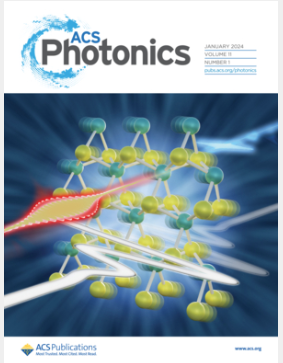尺寸选择金和铜纳米团簇在C60有机衬底上软着陆的局部表面等离子体共振
IF 6.7
1区 物理与天体物理
Q1 MATERIALS SCIENCE, MULTIDISCIPLINARY
引用次数: 0
摘要
本研究利用双光子光电发射光谱(2PPE)研究了沉积在C60衬底上的金(Au)、铜(Cu)和钯(Pd)纳米团簇(NCs)的尺寸依赖的局部表面等离子体共振(LSPR)性质。这些NCs的LSPR响应表现为在偏振光下的光发射增强,主要关注簇大小和电子结构的影响。结果表明,Aun纳米材料在p偏振光下的光电子强度显著增强,当其尺寸超过21个原子(Au21)时,在可见光下表现出明显的LSPR响应。相比之下,即使在大约70-90个原子的大小下,Cun和Pdn nc也表现出最小或没有LSPR响应。这些结果表明,LSPR特性受到电子结构的强烈影响,特别是d-电子在费米能级附近的排列。对于un nc来说,5d电子的相对论效应促进了可见光谱中的LSPR,而对于un nc和Pdn nc来说,狭窄的3d波段和缺乏自由的5s电子分别阻碍了等离子体活动。这项研究强调了d电子构型在决定纳米碳纳米管等离子体特性中的关键作用,为设计具有定制电子和结构特征的先进等离子体纳米材料提供了见解。本文章由计算机程序翻译,如有差异,请以英文原文为准。

Localized Surface Plasmon Resonances of Size-Selected Gold and Copper Nanoclusters Soft-Landed on a C60 Organic Substrate
This study investigates the size-dependent localized surface plasmon resonance (LSPR) properties of gold (Au), copper (Cu), and palladium (Pd) nanoclusters (NCs) deposited on a C60 substrate by using two-photon photoemission spectroscopy (2PPE). The LSPR responses of these NCs are characterized by their photoemission enhancement under polarized light, focusing on the influence of cluster size and electronic structure. The results reveal that Aun NCs exhibit distinct LSPR responses to visible light when their size exceeds approximately 21 atoms (Au21), with significantly enhanced photoelectron intensities under p-polarized light. In contrast, Cun and Pdn NCs, even at sizes of around 70–90 atoms, show minimal or no LSPR responses. These results indicate that LSPR characteristics are strongly influenced by the electronic structure, particularly the arrangement of d-electrons near the Fermi level. For Aun NCs, relativistic effects of 5d-electrons facilitate LSPR in the visible spectrum, whereas narrow 3d-bands and the absence of free 5s electrons hinder plasmonic activity for Cun and Pdn NCs, respectively. This study highlights the critical role of d-electron configurations in determining the plasmonic properties of NCs, providing insights for designing advanced plasmonic nanomaterials with tailored electronic and structural characteristics.
求助全文
通过发布文献求助,成功后即可免费获取论文全文。
去求助
来源期刊

ACS Photonics
NANOSCIENCE & NANOTECHNOLOGY-MATERIALS SCIENCE, MULTIDISCIPLINARY
CiteScore
11.90
自引率
5.70%
发文量
438
审稿时长
2.3 months
期刊介绍:
Published as soon as accepted and summarized in monthly issues, ACS Photonics will publish Research Articles, Letters, Perspectives, and Reviews, to encompass the full scope of published research in this field.
 求助内容:
求助内容: 应助结果提醒方式:
应助结果提醒方式:


